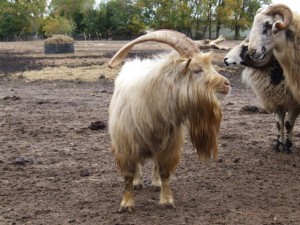
Breed Facts
Status:
Graduated 2013
Use:
Milk
Temperament:
Gentle
Experience Level:
Novice
Notes:
Hardy and Adaptable
NIGERIAN DWARF GOAT
Two miniature goat breeds are found in the United States: the Nigerian Dwarf and the Pygmy. These breeds share a common genetic origin in the variable population of small African goats imported to the U.S. between the 1930s and 1950s. Used originally as exhibition animals in zoos, the goats later became popular as companion animals.
Nigerian Dwarf Goat
The Pygmy was recognized by the American Goat Society in 1976. During the last two decades, it has been standardized through selection for small size and stocky conformation. The breed includes a limited color range, primarily agouti, though other solid colors along with the belted color pattern are also accepted.
The Nigerian Dwarf breed originated from the same genetic foundation as the Pygmy, but has been selected to resemble miniature dairy goats with more slender bodies. All colors and patterns, including bi and tri-color combinations, are accepted. Horns may or may not be present. Nigerian Dwarf goats vary in size, with a bucks’ height reaching up to 23.5 inches at the withers and does 22.25 inches. The ideal size of the breed, however, remains debatable. There are now several breed organizations reflecting differing philosophies.
The Nigerian Dwarf was originally selected as a companion and show animal, with emphasis on the breed’s graceful appearance and gentle disposition. The production qualities of the breed, however, have also attracted attention. Does produce one to two quarts of milk per day. The milk is high in butterfat and makes excellent cheese and butter. They generally breed year-round and produce twins. They can be milked for up to ten months, but can also be allowed to dry up on their own if milking is no longer desired. These production qualities make Nigerian Dwarf goats good candidates for small-scale milk production where a year-round supply of a moderate amount of milk is the goal.
The versatility of the Nigerian Dwarf, as well as its hardiness and gentle disposition, have given it great appeal. The breed’s population has increased significantly in recent years, registering nearly 7,000 purebred animals in 2002 and 5,900 in 2011. The breeder community faces a challenge, however, in determining the parameters of the breed. Selection for production qualities tends to increase the size of the goats, while selection as a companion animal may emphasize small size. Breed conservation will be best served by building consensus around a vision for the breed that includes its unique combination of characteristics.
Nigerian Dwarf goats graduated from The Livestock Conservancy’s priority list in 2013.
Did you know:
The Livestock Conservancy is America’s leading organization working to save over 150 heritage breeds from extinction. We rely on the support of our members, grants, and donations from the public to raise the $700,000 a year needed to maintain our conservation work with rare breeds of farm animals. Click here to learn how you can help.
You may be interested in…

Breed Facts
Status:
Graduated 2013
Use:
Milk
Temperament:
Gentle
Experience Level:
Novice
Notes:
Hardy and Adaptable
You may be interested in…




